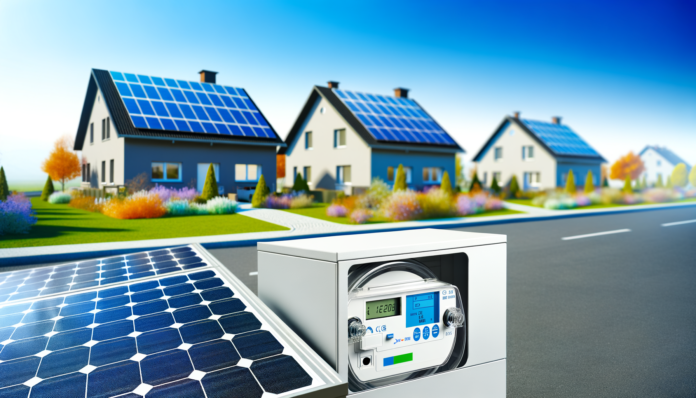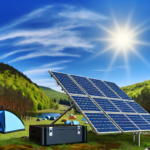Introduction to Smart Living with Solar
Overview of Solar Energy
Solar energy harnesses the power of the sun to generate electricity, offering a renewable and sustainable alternative to fossil fuels. Solar panels, or photovoltaic (PV) systems, convert sunlight directly into electricity, which can be used to power homes, businesses, and even entire communities. The adoption of solar energy has been growing rapidly due to its environmental benefits, cost savings, and advancements in technology. By reducing reliance on non-renewable energy sources, solar energy plays a crucial role in mitigating climate change and promoting a cleaner, greener future.
Introduction to Smart Grids
Smart grids represent the next generation of electrical grids, incorporating digital technology to enhance the efficiency, reliability, and sustainability of electricity distribution. Unlike traditional grids, smart grids use advanced sensors, communication networks, and automation systems to monitor and manage the flow of electricity in real-time. This allows for better integration of renewable energy sources, improved demand response, and enhanced grid resilience. Key components of smart grids include smart meters, distributed energy management systems (DERMS), and advanced metering infrastructure (AMI), all of which contribute to a more dynamic and responsive energy system.
The Intersection of Solar Energy and Smart Grids
The integration of solar energy with smart grids marks a significant advancement in the pursuit of sustainable living. By combining the renewable power of solar panels with the intelligent management capabilities of smart grids, we can create a more efficient and resilient energy system. Smart grids enable the seamless incorporation of solar energy into the grid, allowing for real-time monitoring and optimization of energy production and consumption. This synergy not only maximizes the use of clean energy but also enhances grid stability and reduces energy waste.
One of the key benefits of this integration is the ability to manage distributed energy resources (DERs) effectively. Solar panels installed on homes and businesses can feed excess energy back into the grid, providing additional power during peak demand periods. Smart grids can also facilitate energy storage solutions, such as batteries, to store surplus solar energy for use when sunlight is not available. Furthermore, advanced demand response technologies can adjust energy consumption patterns based on solar energy availability, ensuring that energy is used more efficiently.
In summary, the intersection of solar energy and smart grids represents a transformative approach to energy management. By leveraging the strengths of both technologies, we can achieve a more sustainable, efficient, and resilient energy system that benefits both the environment and consumers. As we continue to innovate and invest in these technologies, the vision of smart living with solar becomes increasingly attainable, paving the way for a cleaner and more sustainable future.
Understanding Smart Grids
What is a Smart Grid?
A smart grid is an advanced electrical grid that uses digital technology to manage the flow of electricity from all sources, including renewable ones like solar power. Unlike traditional grids, which were designed for a one-way flow of electricity, smart grids facilitate a two-way flow of both electricity and information. This allows for real-time monitoring and response, making the grid more efficient, reliable, and adaptable to modern energy needs.
Smart grids are often compared to the internet for electricity. They employ technologies such as the Internet of Things (IoT) and Artificial Intelligence (AI) to connect various devices across the grid, from solar panels on rooftops to power plants miles away. This interconnected network enables the grid to adjust to fluctuating energy demands and supply, ensuring a stable and efficient energy distribution system.
Key Components of Smart Grids
Smart grids are composed of several key components that work together to enhance the efficiency and reliability of the electrical grid:
- Advanced Metering Infrastructure (AMI): These are smart meters that provide real-time data on electricity usage, allowing both consumers and utilities to monitor and manage energy consumption more effectively.
- Distributed Energy Resources (DER): These include small-scale renewable energy sources like solar panels, wind turbines, and battery storage systems that can be integrated into the grid.
- Energy Management Systems (EMS): These systems use AI and machine learning to optimize the distribution and consumption of electricity, balancing supply and demand in real-time.
- Communication Networks: These networks enable the two-way flow of information between utilities and consumers, facilitating real-time monitoring and control of the grid.
- Automated Control Systems: These systems can detect and respond to issues within the grid, such as power outages or equipment failures, minimizing disruptions and improving reliability.
Benefits of Smart Grids
The transition to smart grids offers numerous benefits for both consumers and the environment:
- Increased Efficiency: Smart grids optimize the distribution of electricity, reducing waste and improving overall efficiency. This leads to lower operational costs for utilities and, ultimately, lower electricity bills for consumers.
- Enhanced Reliability: With real-time monitoring and automated control systems, smart grids can quickly detect and address issues, minimizing the impact of power outages and ensuring a more reliable supply of electricity.
- Integration of Renewable Energy: Smart grids are designed to handle the variable nature of renewable energy sources like solar and wind power. This makes it easier to integrate these clean energy sources into the grid, reducing our reliance on fossil fuels and lowering carbon emissions.
- Consumer Empowerment: Smart meters and real-time data provide consumers with greater insight into their energy usage, enabling them to make more informed decisions and reduce their electricity consumption. This can lead to significant cost savings and a smaller carbon footprint.
- Improved Security: The advanced technologies used in smart grids enhance the security of the electrical grid, making it more resilient to cyber-attacks and natural disasters. This ensures a more stable and secure energy supply.
In summary, smart grids represent a significant advancement in how we manage and distribute electricity. By leveraging digital technology and real-time data, they offer a more efficient, reliable, and sustainable energy system that benefits both consumers and the environment.
The Role of Solar Energy in Smart Grids
Integration of Solar Panels with Smart Grids
The integration of solar panels with smart grids represents a significant leap forward in energy management. Smart grids are designed to handle the two-way flow of electricity and information, making them ideal for incorporating renewable energy sources like solar power. When solar panels generate electricity, this energy can be fed directly into the smart grid. Advanced metering infrastructure (AMI) and IoT devices enable real-time monitoring and management of this energy flow, ensuring that the electricity generated by solar panels is efficiently distributed where it is needed most.
Moreover, smart grids can store excess solar energy using energy storage solutions such as batteries. This stored energy can then be used during periods when solar generation is low, such as at night or during cloudy days. This seamless integration ensures a stable and reliable energy supply, maximizing the utility of solar power.
Advantages of Solar Energy in Smart Grids
The integration of solar energy into smart grids offers numerous advantages:
- Environmental Benefits: Solar energy is a clean, renewable resource that significantly reduces carbon emissions. By integrating solar power into smart grids, we can decrease our reliance on fossil fuels and mitigate the impact of climate change.
- Cost Savings: Solar energy can lead to substantial cost savings for both consumers and utilities. Smart grids optimize the use of solar power, reducing the need for expensive peak-time electricity from traditional power plants.
- Energy Independence: Solar energy provides a decentralized source of power, reducing dependence on centralized power plants and enhancing energy security. Smart grids facilitate this by efficiently managing and distributing locally generated solar power.
- Enhanced Grid Resilience: Smart grids can quickly adapt to changes in energy supply and demand, making the grid more resilient to disruptions. The ability to store and redistribute solar energy ensures a continuous power supply even during emergencies.
Challenges and Solutions
While the integration of solar energy into smart grids offers many benefits, it also presents several challenges:
- Intermittency: Solar power is inherently intermittent, as it depends on weather conditions and daylight hours. Smart grids address this challenge by using energy storage solutions and demand response technologies to balance supply and demand.
- Infrastructure Costs: Upgrading existing grid infrastructure to smart grid standards can be costly. However, the long-term benefits of improved efficiency, reliability, and reduced operational costs can outweigh the initial investment.
- Regulatory and Policy Barriers: The integration of solar energy into smart grids requires supportive policies and regulations. Governments and regulatory bodies need to create frameworks that encourage the adoption of smart grid technologies and renewable energy sources.
- Cybersecurity: The digital nature of smart grids makes them vulnerable to cyber-attacks. Implementing robust cybersecurity measures is essential to protect the grid and ensure the secure integration of solar energy.
In conclusion, the role of solar energy in smart grids is pivotal for creating a sustainable and efficient energy future. By addressing the challenges and leveraging the advantages, we can harness the full potential of solar power and smart grid technology to revolutionize our energy systems.
Technological Innovations in Smart Grids and Solar Energy
Advanced Metering Infrastructure (AMI)
Advanced Metering Infrastructure (AMI) is a cornerstone of modern smart grids, enabling two-way communication between utilities and consumers. AMI systems consist of smart meters, communication networks, and data management systems. These smart meters provide real-time data on energy consumption, allowing utilities to monitor and manage the grid more efficiently. For consumers, AMI offers detailed insights into their energy usage, empowering them to make informed decisions to reduce consumption and costs.
The benefits of AMI extend beyond mere data collection. By facilitating dynamic pricing models, AMI allows for time-of-use rates, where electricity prices vary based on demand. This encourages consumers to shift their usage to off-peak times, thereby balancing the load on the grid. Additionally, AMI enhances outage detection and response, enabling quicker restoration of services and improving overall grid reliability.
Energy Storage Solutions
Energy storage solutions are pivotal in addressing the intermittent nature of solar energy. Technologies such as lithium-ion batteries, flow batteries, and even emerging solutions like solid-state batteries are being integrated into smart grids to store excess solar power generated during peak sunlight hours. This stored energy can then be used during periods of low solar generation, such as nighttime or cloudy days, ensuring a consistent and reliable power supply.
One of the most significant advancements in energy storage is the development of grid-scale battery systems. These large-scale storage solutions can store vast amounts of energy and discharge it when needed, helping to stabilize the grid and reduce reliance on fossil fuel-based peaker plants. Moreover, energy storage systems can provide ancillary services such as frequency regulation and voltage support, further enhancing grid stability and efficiency.
Demand Response Technologies
Demand response technologies play a crucial role in balancing supply and demand within smart grids. These technologies enable utilities to adjust the power consumption of connected devices in real-time, based on grid conditions. For instance, during periods of high demand, utilities can remotely reduce the power usage of non-essential appliances in participating homes and businesses, thereby preventing grid overloads and reducing the need for additional power generation.
Demand response programs often involve financial incentives for consumers who participate, making it a win-win situation. Consumers benefit from lower energy bills, while utilities gain a flexible tool to manage grid stability. Advanced demand response systems leverage machine learning and artificial intelligence to predict consumption patterns and optimize load adjustments, making the process more efficient and less intrusive for consumers.
In conclusion, the integration of Advanced Metering Infrastructure, energy storage solutions, and demand response technologies is revolutionizing the way smart grids interact with solar energy. These innovations not only enhance grid reliability and efficiency but also empower consumers to take an active role in energy management, paving the way for a more sustainable and resilient energy future.
Case Studies and Real-World Applications
Residential Applications
The integration of solar energy with smart grids in residential settings has shown significant promise. Homeowners are increasingly adopting solar panels, which are connected to smart grids to optimize energy consumption and production. **Smart meters** and **home energy management systems (HEMS)** play a crucial role in this integration. These technologies allow homeowners to monitor their energy usage in real-time, adjust their consumption patterns, and even sell excess energy back to the grid.
For instance, in the HafenCity district of Hamburg, Germany, residents use electric vehicles (EVs) as virtual buffers. The smart grid delays the charging of EVs to periods of low energy demand, thus balancing the grid and reducing peak loads. This not only ensures efficient energy use but also minimizes costs for residents. Additionally, household appliances like washing machines and dishwashers are integrated into the smart grid, allowing their operation to be scheduled during off-peak hours, further optimizing energy consumption.
Commercial and Industrial Applications
Commercial and industrial sectors are also leveraging the synergy between solar energy and smart grids. Businesses are installing large-scale solar panels to power their operations, and smart grids are helping them manage this energy efficiently. **Advanced Metering Infrastructure (AMI)** and **demand response technologies** are particularly beneficial in these settings.
For example, the Port of Hamburg uses Automated Guided Vehicles (AGVs) powered by lithium-ion batteries. These AGVs can delay their energy demand or act as power banks, feeding energy back into the grid when not in use. This flexibility helps in managing the energy load and ensures that the port operations are not disrupted. The Container Terminal Altenwerder (CTA) at the port can feed up to 4 MW back into the grid, showcasing the potential of industrial applications in smart grid integration.
Off-Grid and Remote Area Applications
In off-grid and remote areas, the combination of solar energy and smart grids is transforming lives. These regions often lack reliable access to traditional power grids, making solar energy an ideal solution. Smart grids enhance the efficiency and reliability of these solar systems, ensuring a stable power supply.
One notable example is the use of solar microgrids in remote villages in India. These microgrids are equipped with energy storage solutions and smart meters, allowing for efficient energy distribution and management. Residents can monitor their energy usage and adjust their consumption to match the available solar power, ensuring a continuous power supply even during cloudy days or at night.
In another case, remote research stations in Antarctica use solar panels integrated with smart grids to power their operations. The smart grid technology helps in managing the energy storage and distribution, ensuring that the research activities are not hampered by power shortages.
In conclusion, the integration of solar energy with smart grids is proving to be a game-changer across various sectors. From residential homes to industrial complexes and remote areas, this synergy is enhancing energy efficiency, reducing costs, and promoting sustainability. As technology continues to evolve, the potential for smart living with solar energy will only grow, paving the way for a more sustainable future.
Environmental and Economic Impact
Reducing Carbon Footprint
The integration of solar energy with smart grids plays a pivotal role in reducing the carbon footprint. Traditional energy sources, such as coal and natural gas, emit significant amounts of carbon dioxide and other greenhouse gases when burned for electricity. In contrast, solar energy is a clean, renewable resource that generates power without emitting harmful pollutants. By leveraging smart grids to efficiently manage and distribute solar energy, we can significantly cut down on carbon emissions. This shift is crucial in combating climate change and promoting a healthier environment. Smart grids enhance the reliability and efficiency of solar energy, ensuring that even on cloudy days or during peak demand, the energy supply remains stable and green.
Cost Savings and Efficiency
One of the most compelling benefits of integrating solar energy with smart grids is the potential for substantial cost savings and increased efficiency. Smart grids utilize advanced technologies such as real-time monitoring, automated control systems, and demand response mechanisms to optimize energy distribution. This means that energy is used more efficiently, reducing waste and lowering operational costs. For consumers, this translates to lower electricity bills. Solar energy, being a free resource once the initial installation costs are covered, further contributes to cost savings. Additionally, smart grids can store excess solar energy generated during peak sunlight hours and redistribute it during periods of high demand, ensuring a consistent and cost-effective energy supply.
Long-Term Sustainability
The integration of solar energy with smart grids is not just a short-term solution; it is a cornerstone for long-term sustainability. As the world moves towards more sustainable energy practices, the role of smart grids becomes increasingly important. These grids are designed to be adaptable and scalable, capable of integrating various renewable energy sources beyond just solar, such as wind and hydroelectric power. This adaptability ensures that as technology evolves and new renewable energy sources become viable, they can be seamlessly incorporated into the existing grid infrastructure. Moreover, the use of smart grids promotes energy independence and security, reducing reliance on fossil fuels and imported energy. This not only supports environmental sustainability but also enhances economic stability by mitigating the risks associated with fluctuating energy prices and supply disruptions.
In conclusion, the integration of solar energy with smart grids offers significant environmental and economic benefits. By reducing carbon emissions, lowering energy costs, and promoting long-term sustainability, this innovative approach is paving the way for a cleaner, more efficient, and resilient energy future.
Future Trends and Developments
Emerging Technologies
The future of smart grids and solar energy integration is being shaped by a host of emerging technologies. **Advanced Metering Infrastructure (AMI)** is at the forefront, enabling real-time data collection and analysis to optimize energy distribution. **Distributed Energy Management Systems (DERMS)** are also gaining traction, leveraging small-scale renewable plants, EV charging points, and battery storage systems to address local grid issues like voltage regulation and congestion management.
**Energy storage solutions** are another critical area of innovation. Enhanced battery technologies are making it possible to store solar energy more efficiently, ensuring a stable supply even when the sun isn’t shining. Additionally, **Flexible Alternating-Current Transmission Systems (FACTS)** and advanced sensors like phasor measurement units are improving the control, monitoring, and optimization of power grids.
**Artificial Intelligence (AI)** and **Machine Learning (ML)** are being increasingly integrated into smart grids to predict energy demand, optimize energy flow, and even foresee and mitigate potential grid failures. These technologies are not just making grids smarter but also more resilient to disruptions.
Policy and Regulatory Changes
The integration of solar energy with smart grids is also being influenced by evolving policy and regulatory landscapes. Governments worldwide are recognizing the importance of renewable energy and are implementing policies to support its adoption. For instance, **feed-in tariffs** and **tax incentives** are encouraging more households and businesses to install solar panels.
Regulatory bodies are also focusing on **grid modernization**. Policies are being crafted to support the deployment of smart meters, the automation of substations, and the integration of distributed energy resources. These regulations aim to create a more flexible and resilient energy grid capable of handling the complexities of renewable energy sources.
Moreover, **environmental regulations** are pushing for a reduction in carbon emissions, making the adoption of solar energy and smart grids not just an option but a necessity. These policies are driving significant investment in renewable energy infrastructure, further accelerating the transition to a sustainable energy future.
The Future of Smart Living with Solar
The future of smart living with solar energy is incredibly promising. As technology continues to advance, we can expect even greater efficiency and reliability in our energy systems. **Smart homes** equipped with solar panels and connected to smart grids will become the norm, allowing for seamless energy management and significant cost savings.
**Electric vehicles (EVs)** will play a crucial role in this future. Smart grids will integrate EV charging stations, providing the necessary visibility and control to mitigate grid bottlenecks. This will not only support the growth of the EV market but also contribute to a more sustainable transportation system.
**Disaster resilience** will also be a key focus. Technologies like Spark Prevention Units and geographic information systems will help predict and prevent damage to grid assets, ensuring a more robust and reliable energy supply even in the face of natural disasters.
In summary, the integration of solar energy with smart grids is set to revolutionize how we live and consume energy. With the continuous development of emerging technologies, supportive policies, and a focus on sustainability, the future of smart living with solar is bright and full of potential.






